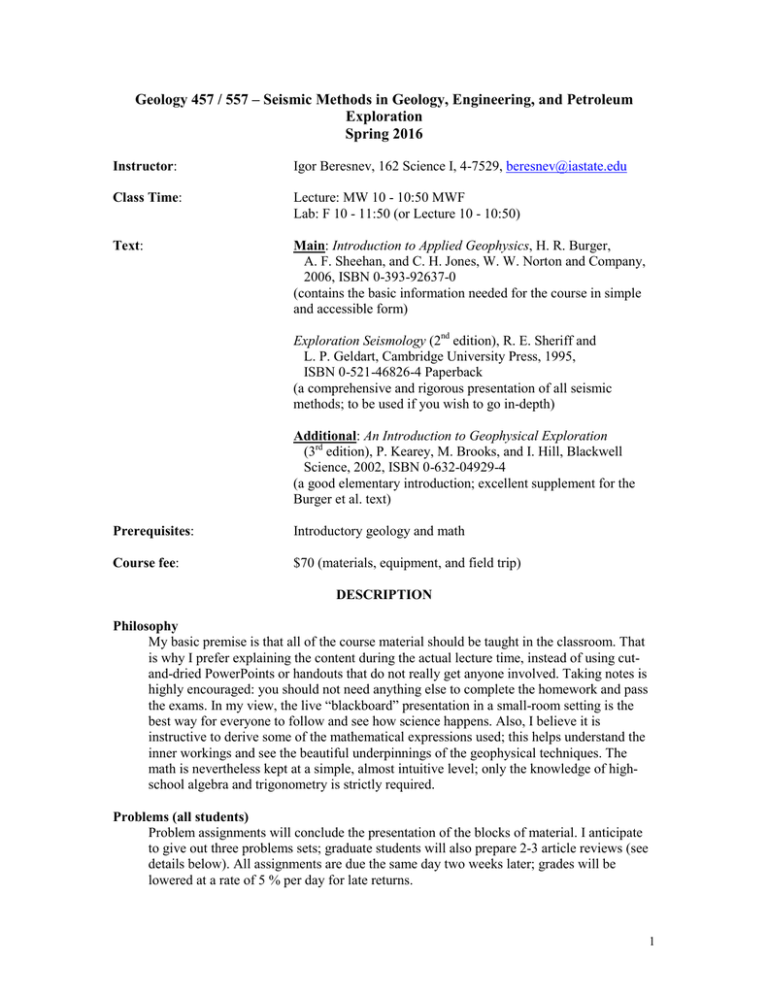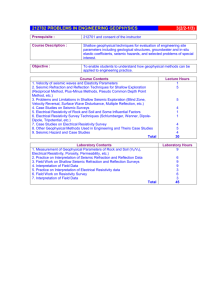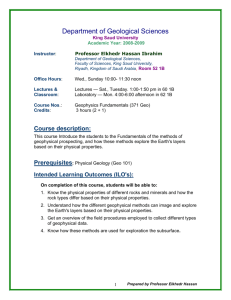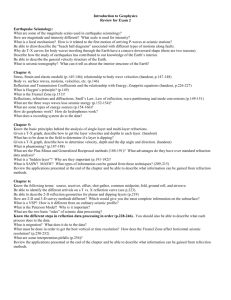Geology 457 / 557 – Seismic Methods in Geology, Engineering,... Exploration Spring 2016
advertisement

Geology 457 / 557 – Seismic Methods in Geology, Engineering, and Petroleum Exploration Spring 2016 Instructor: Igor Beresnev, 162 Science I, 4-7529, beresnev@iastate.edu Class Time: Lecture: MW 10 - 10:50 MWF Lab: F 10 - 11:50 (or Lecture 10 - 10:50) Text: Main: Introduction to Applied Geophysics, H. R. Burger, A. F. Sheehan, and C. H. Jones, W. W. Norton and Company, 2006, ISBN 0-393-92637-0 (contains the basic information needed for the course in simple and accessible form) Exploration Seismology (2nd edition), R. E. Sheriff and L. P. Geldart, Cambridge University Press, 1995, ISBN 0-521-46826-4 Paperback (a comprehensive and rigorous presentation of all seismic methods; to be used if you wish to go in-depth) Additional: An Introduction to Geophysical Exploration (3rd edition), P. Kearey, M. Brooks, and I. Hill, Blackwell Science, 2002, ISBN 0-632-04929-4 (a good elementary introduction; excellent supplement for the Burger et al. text) Prerequisites: Introductory geology and math Course fee: $70 (materials, equipment, and field trip) DESCRIPTION Philosophy My basic premise is that all of the course material should be taught in the classroom. That is why I prefer explaining the content during the actual lecture time, instead of using cutand-dried PowerPoints or handouts that do not really get anyone involved. Taking notes is highly encouraged: you should not need anything else to complete the homework and pass the exams. In my view, the live “blackboard” presentation in a small-room setting is the best way for everyone to follow and see how science happens. Also, I believe it is instructive to derive some of the mathematical expressions used; this helps understand the inner workings and see the beautiful underpinnings of the geophysical techniques. The math is nevertheless kept at a simple, almost intuitive level; only the knowledge of highschool algebra and trigonometry is strictly required. Problems (all students) Problem assignments will conclude the presentation of the blocks of material. I anticipate to give out three problems sets; graduate students will also prepare 2-3 article reviews (see details below). All assignments are due the same day two weeks later; grades will be lowered at a rate of 5 % per day for late returns. 1 Please keep these simple rules in mind when working on a problem assignment. (1) Carefully explain all your work and the steps taken at arriving at the solution. No problem is considered complete with only the final answer given. (2) Make the final result clearly seen. Labs and field trip During the labs, we will sample some real-world seismic-interpretation software. We will also go out to conduct a shallow geophysical survey using modern seismic-acquisition equipment (the StrataView 24-channel engineering seismograph). The trip will take place some time in April, when the weather warms up; the exact time will be announced. Note that the survey will take about 4 hours and will not necessarily coincide with the regular class time; we may have to set aside a time outside the normal class schedule. Article critiques (graduate students) The purpose of journal reading is to acquire familiarity with some typical case histories in seismic exploration, develop writing habits, and strengthen the ability to view the work of others critically. There will be approximately three reviews, alternating with the problem assignments. The following rules will apply. (1) The review should present an analysis of the contents of the article, not a simple recitation of what it is about. I will be looking for your own thoughts on the quality of the paper, its strengths and weaknesses, and any issues left unresolved. Your critique should demonstrate that you have read and understood the paper. Ideally, put the article aside when finished reading and start writing about your impressions in your own language. It may help if you picture yourself an external referee asked by a journal editor to provide an expert opinion on whether this article is worth being published. (2) I will evaluate the critiques according to both criteria of comprehension and style. (3) Generally, limit yourself to two double-spaced pages, excluding figures. Do not overdo; try to be concise and to-the-point. Important: sometimes students fill their reviews with excerpts taken directly from the article; this is not acceptable and will significantly lower the grade. You should write in your own words, showing your understanding of the subject. (4) The reviews will be due the same day two weeks later. The same grade-reduction rule as for the problem sets will apply to late returns. Written exams There will be two intermediate exams and a final exam. The exams will include problem solving and a matching exercise; the problems will be similar to those given as homework and will only cover the lecture material. All exams require calculator and paper. Final grading Exams (average) Problems (average) Article reviews (average) 457 60 % 40 % 557 50 % 30 % 20 % 2 Schedule Date Week 1 / January 11-15 Week 2 / January 18-22 Week 3 / January 25-29 Week 4 / February 1-5 Week 5 / February 8-12 Week 6 / February 15-19 Week 7 / February 22-26 Week 8 / February 29-March 4 Week 9 / March 7-11 Topic Introduction. History of exploration seismology. Outline of the seismic methods. Elasticity. Wave physics. Wave equation. Plane and spherical waves. Harmonic waves. Types of seismic waves. Seismic velocities in earth materials. Wave energy and attenuation. Reflection and refraction. Fermat’s principle. Snell’s law. Critical refraction and head waves. Travel-time curves. Diffraction. Lab. Wave modeling using program REFLECT. Wave partitioning at an interface. Zoeppritz equations. Reflection and refraction coefficients. Normal and oblique incidence. Amplitude variation with angle. Idea of the seismic-refraction method. Horizontal refractors. Exam 1 Dipping refractors. Exploration methods based on refraction. Lab. Refraction-interpretation package SIP. Preparation of input data for automated interpretation. The seismic-reflection method in the shallow environment. Horizontal and dipping reflectors. Normal move-out, dip move-out. Lab. Refraction-interpretation package SIP. Refraction travel-time curves. Overview of seismic equipment. Introduction to petrophysical models. Velocity in a pack of uniform spheres, Gassmann’s model. Factors affecting seismic velocities in rock. Lab. Automated refraction interpretation using SIP. March 14-18 Week 10 / March 21-25 Week 11 / March 28-April 1 Week 12 / April 4-8 Spring Break Measurement of seismic velocities. The seismicreflection method in the deep environment. Reflection from stacks of horizontal layers. The Dix approximation. Static corrections. Multiple reflections. Exam 2 Resolution. Time sections. The common-depth-point (CDP) method. 3 Week 13 / April 11-15 Week 14 / April 18-22 Week 15 / April 25-29 Week of May 2-6 Lab. Reflection modeling and interpretation using program REFLECT. Velocity analysis. NMO corrections. Stacking. The CDP method in case of dipping layers. Lab. Field refraction survey with the StrataView engineering seismograph (exact time to be announced). Seismic migration. Geophone arrays. Calculation of array directivity. American Association of Petroleum Geologists’ video “Introduction to seismic reflection surveying”. Geologic interpretation of reflection data. Final Exam 4






